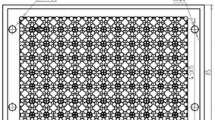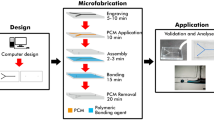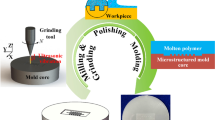Abstract
Microfluidics has been widely used in biological, chemical, medical and environmental fields for the precise control of liquid in micro/nanoscale. Various fabrication methods have been invented based on polymer materials in the past decade. Currently, under the circumstance of massive fabrication of microfluidic devices, injection molding is still the cheapest and fastest approaches. Injection molding products have been widely used in everyday life, however, the injection molding of polymer-based microfluidics has not been extensively investigated in the previous studies. In this study, we proposed a relatively comprehensive fabrication procedure for the injection molding of polymer microfluidic chips: the testing microfluidic chip with typical microfluidic components were designed, followed with mold design and fabrication; a single screw injection molding machine was used for the fabrication of PMMA-based microfluidic chips under different processing parameters; finally, another layer of polymer sheet was bonded to seal the microchannel and chip’s functionality was tested. The profile of the fabricated microchannels, as well as surface quality under difference injection molding parameters was also discussed in this study. This study is trying to provide a comprehensive injection molding approach for polymer-based microfluidics, the chip and injection mold design process, as well as the injection molding parameters, could have reference value for the future massive production of polymer microfluidic chips for biological and medical applications.
Similar content being viewed by others
Explore related subjects
Discover the latest articles, news and stories from top researchers in related subjects.Avoid common mistakes on your manuscript.
1 Introduction
Microfluidic technology has been widely used in the biological (Newman et al. 2019), chemical (Auner et al. 2019), medical (Sontheimer-Phelpset al. 2019), and environmental (Chung et al. 2019) fields for the precise handling of liquid in micro/nanoscale. Early microfluidics devices were fabricated with silicon or glass material with fabrication technologies inherited from MEMS (micro-electro-mechanical systems) (Sanjoh and Tsukihara 1999), which usually involved complicated photolithography and chemical/physical etching process.
In the past decade, the polymers have become alternative materials in microfluidics and largely replaced silicon/glass material, polymer materials offer various options on optical, chemical, and physical properties (Hou et al. 2017; Tsao 2016). Comparing with silicon/glass, polymer materials are usually low-cost, easy to process with various fabrication methods. Currently, both thermoplastics and thermosets have been extensively used in microfluidics, e.g., PMMA (polymethyl methacrylate) (Wan et al. 2017), PS (polystyrene) (Pentecost and Martin 2015), PC (polycarbonate) (Su et al. 2019) and PDMS (polydimethylsiloxane) (Choi et al. 2018).
The fabrication techniques for polymer microfluidics have been extensively explored with researchers around the world, including replica molding (Sticker et al. 2015), hot embossing (Lin et al. 2017), laser ablation (Liu et al. 2018), injection molding (Lee et al. 2018), 3D printing (Bhattacharjee et al. 2016), etc. However, most of the previously mentioned technique is only suitable for fabricate single or small amount of microfluidic chips for research purpose. For the massive fabrication of polymer-based microfluidic chips, some of the most promising approach including roll-to-roll embossing method for thin-film microfluidics (Wang et al. 2016) and injection molding method for thermoplastic-based microfluidics (Viehrig et al. 2018; Lee et al. 2018). Mair et al. use injection molding method fabricated COC-based microfluidics with integrated connectors (Mair et al. 2006), and Lee et al. also use fabricated COC-based microfluidics for cell assays using injection molding (Lee et al. 2018). Although several approach have been made, so far, however, there is still in lack of extensive studies for injection molding approach in massive fabrication of polymer-based microfluidic chips, especially for PMMA-based microfluidic devices fabricated with injection molding, which is of great significance for the future application of microfluidics in biological and medical fields.
In this study, we designed a microfluidic chip that has some of the most commonly used microfluidic features, then we designed and fabricated the injection mold system. After that, the PMMA-based microfluidic chips were fabricated using injection molding method with various parameter settings for optimization. Then, we obtained the profile measurement and surface roughness data with laser confocal microscope. Finally, the injection-molded chip was bonded with another layer of thermoplastics to seal the channel and conducted the fluid test. This study proposed a relatively comprehensive procedure for the fabrication of thermoplastic-based microfluidics, and have reference value for the future massive fabrication of microfluidic devices.
2 Experimental
2.1 Chip design
In order to demonstrate the injection molding method proposed in this study, a test chip was designed with some of the most commonly used microfluidic components as shown in Fig. 1. The external dimension of the chip is 25.4 mm by 76.2 mm from the standard microscope slide size, with a thickness of 1.5 mm. The designed microfluidics components including a single emulsion generator (with droplet storage reservoir), a double emulsion generator (with columns array in reservoir), a diffusion mixer (channel depth and width are 400 μm), and three straight channel with different dimensions (channel depth and width from 300 to 500 μm).
The actual dimension of the microfluidic components on metal mold was adjusted a little bit due to the shrinkage and demold requirement of the injection molding process. The adjustments in the mold design process is in order to match (neutralize) the shrinkage of structures after injection molding. Besides, the cross-section of the microchannels is not in a perfectly square profile, instead, a trapezoid profile with an angle of 1o (draft angle) was designed for smooth demolding.
In this study, the PMMA was selected for the injection molding of the microfluidic chips. PMMA is a low-cost, transparent and easy assessable thermoplastic and has been widely used in polymer microfluidics with laser ablation (Klank et al. 2002), hot embossing (Mathur et al. 2009), and Deep-UV radiation (Liang et al. 2018). In this study, we designed and fabricated a mold system for the injection molding of PMMA-based microfluidic chips, the physical properties of PMMA pellets used in this study were shown in Table 1.
2.2 Mold design
The assembly of the injection mold is shown in Fig. 2a, b, the mold was designed with Siemens NX, Siemens PLM Software Inc. The mold used in this study is a typical 2-plate (two-platen) mold, with the advantages in the relatively simple design and easy to handle. The nozzle side assembly mainly includes the location ring, stationary plate, and cavity; the ejector side mainly contains core, movable plate, ejector and temperature control system (shown in Fig. 2a).
Comparing with the design of conventional daily-use plastic products’ mold, the microfluidic chip mold design have several key considerations: firstly, the chip’s external dimension is in millimeter while the profile the microchannel is in micrometer, multiscale design need to be cautious on the surface roughness and machining precision requirements; secondly, the microfluidic chip contains structure in micro-scale which is sensitive to temperature change due to the scaling law, thus the heating and cooling system (Fig. 2c) need to be highly efficient with rapid response; thirdly, after careful evaluation of various gate types, the side gate (shown in Fig. 2d) was chosen for the best filling of the thin-wall like structure, i.e. microfluidic chips.
2.3 Injection fabrication
The injection molding of microfluidic chips need to fill the narrow (micro-scale) cavities, the narrow cavities are more resistive during the injection molding process and more sensitive to the cooling effect due to the scaling effect. The precise control of injection molding parameters, especially the injection pressure and mold temperature.
For the optimization of the injection molding process before the actual injection molding experiment, the injection molding process was simulated using Moldflow (Autodesk, Inc., USA) for the initial selection of the gate type, runner dimension, injection pressure, injection speed, mold temperature, as well as several other critical parameters in the injection molding process. The simulation provided an estimate of the filling process, including fill time, pressure drop, air traps, and wield lines. The simulated fill process and time is shown in Fig. 3, the entire fill takes about 0.88 s.
For injection molding, for preparation, the PMMA pellets were dried at 75 °C for 2 h for the removal of moisture. Then, a horizontal single screw injection molding machine (EcoPower 55-300t, WITTMANN Group, Germany, shown in Fig. 4) was used for the injection molding process. For the injection molding machine, the screw diameter is 22 mm, with a maximum injection pressure of 320 MPa, maximum injection speed of 400 mm/s, maximum screw speeds of 230 rpm, and maximum clamping force of 300 ton.
The fabricated microfluidic chips is shown in Fig. 5, a mold with two cavities structure was used for the injection molding of microfluidic chips, the injection pressure was set at 120 MPa, with injection speed ranges from 200 mm/s to 400 mm/s, the mold temperature was set at 60 °C with the help of oil mold temperature controller. Each cycle of injection molding takes around 45 s. The detailed discussion between the injection molding parameters and the quality of the fabricated microstructures will be provided in the followed session.
3 Discussion
A laser confocal microscope (LEXT OLS5000, Olympus Corporation, Japan) was used for the observation of the surface profile and roughness of the fabricated microchannels after injection molding (shown in Fig. 6). The inserts in Fig. 6 were the software (OLS50-BSW) rebuild of the 3D structure of the laser scan data. For laser confocal microsphere, the long WD 20× lens was used during the measurement with the 405 nm violet laser (0.3 mW power output), with the scan line speed set at medium.
As previous introduced, with the influence from thermal shrinkage and designed draft angle, the cross-section profile of the fabricated microchannels is not in a perfect square shape, the parameters definition of the channel is shown in Fig. 7 (obtained with laser confocal microscope). For the microchannel shown in Fig. 7 (with designed dimension 400 μm by 400 μm), the measured depth is around 408 μm, the bottom width is around 425 μm, and the top width (channel opening) is around 630 μm. For injection molding parameters used in Fig. 7, mold temperature was set at 70 °C, melt temperature 280 °C, injection pressure 120 MPa, holding pressure of 50 MPa for 5 s, with a cooling time of 25 s. The designed draft angle of the fabricated microchannel can be observed from Fig. 7, which was used for demolding during the injection molding process.
The measurement results of the microchannels under different injection molding parameters were shown in Table 2 (each measured data is the average of three repeated measures). As shown in Table 2, the top width of the microchannels is obviously wider than the bottom width, which was caused by a joint effect of mold design and filling process. It can also be observed from Table 2 that, the increase of injection speed could significantly lower the surface roughness, the increase of melt temperature could slightly constrain the increase of channel top width and lower the surface roughness. However, it has to been mentioned that, the final structure and surface quality of fabricated plastic microfluidic devices is rely on the joint effect of melt temperature of thermoplastics, mold temperature, holding pressure, and injection speed.
Although the filling simulation was conducted in the mold design process, some defects were still observed (shown in Fig. 8) in the injection molding process with the improper setting of the injection pressure, injection speed, melt temperature or mold temperature. However, these defects were eventually eliminated after several trials. Figure 8a shows the short shot, the molten PMMA not able to fully fill the cavity, the short shot issue in our case was solved by increasing the mold and melt temperature to improving the fluidity. Figure 8b shows the cracks, caused by the accumulation of the stress in the injection molding process, the solution taken is to decreases the holding pressure while increasing the cooling time to reduce the stress. Figure 8c shows the splay, in our case, caused by insufficient drying of PMMA pellets before the injection molding process, this issue was resolved with an extension of the drying time. Figure 8d shows the back specks, caused by overheat and degradation of the material, the back specks were eliminated with proper control of the barrel and injection nozzle temperature.
After the injection molding of the microfluidic chips, the fabricated microchannels need to be sealed with another layer of materials. In our case, for injection molded PMMA chips was thermally bonded with a layer of PMMA sheet (covering layer, same dimensions with a thickness of 1 mm). The thermal bonding was conducted with a pressure of 400 N at 105 °C for 15 min, followed with natural cooling. The covering layer has CO2 laser ablated through holes for the liquid inlet and outlet, after piping (PE, 1.5 mm OD), the device was ready for test. The insert in Fig. 9 shows a typical diffusion mixer that widely used in microfluidics, a short video for the diffusion mixing was also provided.
4 Conclusion
This study introduced a relatively comprehensive process for the injection molding of the thermoplastic-based microfluidic device. The demonstrated microfluidic chip has several most commonly used microfluidic components, the injection mold was then designed and fabricated based on the microfluidic chip configuration, after that, the injection molding process with a commercial injection extruder was conducted with various parameter settings. The surface roughness and cross-section profile of the fabricated microchannels were examined with a laser confocal microscope. Finally, the fabricated microfluidic chip was bonded with another layer of polymer sheet to seal the channel and performed the flow test.
Unlike conventional plastic products, the microfluidic chips contain multiscale structures ranges from millimeter to micrometer. For the injection molding approach, besides the careful design of runners and gates, the filling simulation is also essential for the optimization of mold design. Besides mold design, in the fabrication process, injection pressure, injection speed and melt temperature also need to be carefully adjusted to meet the requirement.
We have to admit that the injection molding process, by nature, is only suitable for the massive production of the polymer microfluidic chips. The major cost comes from mold design and fabrication. However, up to now, the injection molding still seems to be one of the very limited options for the future massive production of microfluidic devices, and have board applications in biological and medical fields.
There are also several aspects not covered in this study, which also might worth of exploration in the future. The injection molding approach of thermoset and the elastomer-based microfluidic device is rarely reported previously, which may need further studies on mold design and injection molding mechanism. The in molding chip bonding might be another interesting topic, the injection molded chip could be bonded with the cover plate inside the mold after injection process, which has critical practical value for the rapid and massive production of polymer microfluidic devices.
References
Auner AW et al (2019) Chemical-PDMS binding kinetics and implications for bioavailability in microfluidic devices. Lab Chip 19(5):864–874
Bhattacharjee N et al (2016) The upcoming 3D-printing revolution in microfluidics. Lab Chip 16(10):1720–1742
Choi C-H, Lee H, Weitz DA (2018) Rapid patterning of PDMS microfluidic device wettability using syringe-vacuum-induced segmented flow in nonplanar geometry. ACS Appl Mater Interfaces 10(4):3170–3174
Chung S et al (2019) Smartphone-based paper microfluidic particulometry of norovirus from environmental water samples at the single copy level. ACS Omega 4(6):11180–11188
Hou X et al (2017) Interplay between materials and microfluidics. Nat Rev Mater 2(5):17016
Klank H, Kutter JP, Geschke O (2002) CO 2-laser micromachining and back-end processing for rapid production of PMMA-based microfluidic systems. Lab Chip 2(4):242–246
Lee UN et al (2018a) Fundamentals of rapid injection molding for microfluidic cell-based assays. Lab Chip 18(3):496–504
Lee Y et al (2018b) Microfluidics within a well: an injection-molded plastic array 3D culture platform. Lab Chip 18(16):2433–2440
Liang C et al (2018) One-step selective-wettability modification of PMMA microfluidic devices by using controllable gradient UV irradiation (CGUI). Sensors and Actuators B: Chemical 273:1508–1518
Lin T-Y et al (2017) 3D printed metal molds for hot embossing plastic microfluidic devices. Lab Chip 17(2):241–247
Liu S et al (2018) Fabrication of cyclo-olefin polymer-based microfluidic devices using CO2 laser ablation. Mater Res Express 5(9):095305
Mair DA et al (2006) Injection molded microfluidic chips featuring integrated interconnects. Lab Chip 6(10):1346–1354
Mathur A et al (2009) Characterisation of PMMA microfluidic channels and devices fabricated by hot embossing and sealed by direct bonding. Curr Appl Phys 9(6):1199–1202
Newman S et al (2019) High density DNA data storage library via dehydration with digital microfluidic retrieval. Nat Commun 10(1):1706
Pentecost AM, Martin RS (2015) Fabrication and characterization of all-polystyrene microfluidic devices with integrated electrodes and tubing. Anal Methods 7(7):2968–2976
Sanjoh A, Tsukihara T (1999) Spatiotemporal protein crystal growth studies using microfluidic silicon devices. J Cryst Growth 196(2–4):691–702
Sontheimer-Phelps A et al (2019) Modelling cancer in microfluidic human organs-on-chips. Nat Rev Cancer 19(2):65–81
Sticker D et al (2015) Multi-layered, membrane-integrated microfluidics based on replica molding of a thiol–ene epoxy thermoset for organ-on-a-chip applications. Lab Chip 15(24):4542–4554
Su S et al (2019) One-step bonding and hydrophobic surface modification method for rapid fabrication of polycarbonate-based droplet microfluidic chips. Sens Actuators B Chem 282:60–68
Tsao C-W (2016) Polymer microfluidics: simple, low-cost fabrication process bridging academic lab research to commercialized production. Micromachines 7(12):225
Viehrig M et al (2018) Injection-molded microfluidic device for SERS sensing using embedded Au-capped polymer nanocones. ACS Appl Mater Interfaces 10(43):37417–37425
Wan AM, Devadas D, Young EW (2017) Recycled polymethylmethacrylate (PMMA) microfluidic devices. Sens Actuators B Chem 253:738–744
Wang X et al (2016) A disposable, roll-to-roll hot-embossed inertial microfluidic device for size-based sorting of microbeads and cells. Lab Chip 16(10):1821–1830
Acknowledgements
This work was supported by the National Natural Science Foundation of China (No. 51804014) and Beijing Natural Science Foundation (2182055).
Author information
Authors and Affiliations
Corresponding author
Additional information
Publisher's Note
Springer Nature remains neutral with regard to jurisdictional claims in published maps and institutional affiliations.
Rights and permissions
About this article
Cite this article
Ma, X., Li, R., Jin, Z. et al. Injection molding and characterization of PMMA-based microfluidic devices. Microsyst Technol 26, 1317–1324 (2020). https://doi.org/10.1007/s00542-019-04662-2
Received:
Accepted:
Published:
Issue Date:
DOI: https://doi.org/10.1007/s00542-019-04662-2













